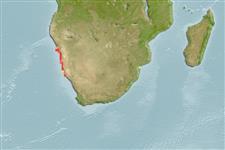Common names from other countries
>
Eupercaria/misc (Various families in series Eupercaria) >
Sparidae (Porgies)
Etymology: Chrysoblephus: Greek, chrysos = golden + Greek, blepo, blepharizo = to watch (Ref. 45335).
More on author: Valenciennes.
Environment: milieu / climate zone / depth range / distribution range
Ecologia
marinhas demersal; intervalo de profundidade 1 - 100 m (Ref. 3198). Tropical; 21°S - 28°S
Southeast Atlantic: northern Namibia to northern Natal, South Africa; also reported from Mauritius.
Comprimento de primeira maturação / Tamanho / Peso / Idade
Maturity: Lm 18.1 range ? - 22.5 cm
Max length : 50.0 cm TL macho/indeterminado; (Ref. 3507); common length : 32.0 cm TL macho/indeterminado; (Ref. 3507); peso máx. publicado: 4.2 kg (Ref. 3670)
Descrição suscinta
Chaves de identificação | Morfologia | Morfometria
Espinhos dorsais (total) : 11 - 12; Raios dorsais (total) : 10 - 11; Espinhos anais: 3; Raios anais : 7 - 9. Usually reddish orange in color, but sometimes blue with a white patch on the side (Ref. 3198).
Occurs above rocky bottoms in deeper water to 100 m but often caught from shore. Juveniles occur in shallow-water beds of seaweed where they feed on minute crustacean (Ref. 3670). Feeds on mollusks, crustaceans, worms and fish. Females transform into territorial males with growth (Ref. 3198). Voracious but sluggish, takes any bait. Good food fish (Ref. 3198). Sold fresh (Ref. 3507). It is parasitised by the monogenean Anoplodiscus cirrusspiralis on the fins and body surface (Ref. 124057).
Ciclo de vida ou comportamento de acasalamento
Maturities | Reprodução | Spawnings | Egg(s) | Fecundities | Larvas
Also Ref. 28504.
Bauchot, M.-L. and M.M. Smith, 1984. Sparidae. In W. Fischer and G. Bianchi (eds.) FAO species identification sheets for fishery purposes. Western Indian Ocean (Fishing Area 51). volume 4. [var. pag.] FAO, Rome. (Ref. 3507)
Status na Lista Vermelha da UICN (Ref. 130435)
CITES (Ref. 128078)
Not Evaluated
Ameaça para os humanos
Harmless
Uso pelos humanos
Pescarias: espécies comerciais; peixe esportivo: sim; Aquário: Potencial
Ferramentas
Relatórios especiais
Baixar XML
Fontes da internet
Estimates based on models
Índice de diversidade filogenética (Ref.
82804): PD
50 = 0.5156 [Uniqueness, from 0.5 = low to 2.0 = high].
Bayesian length-weight: a=0.01778 (0.01107 - 0.02856), b=3.00 (2.86 - 3.14), in cm Total Length, based on LWR estimates for this species & Genus-body shape (Ref.
93245).
Nível Trófico (Ref.
69278): 4.0 ±0.0 se; based on diet studies.
Resiliência (Ref.
120179): médio(a), tempo mínimo de duplicação da população 1,4 - 4,4 anos (K=0.16).
Fishing Vulnerability (Ref.
59153): Moderate to high vulnerability (54 of 100).
